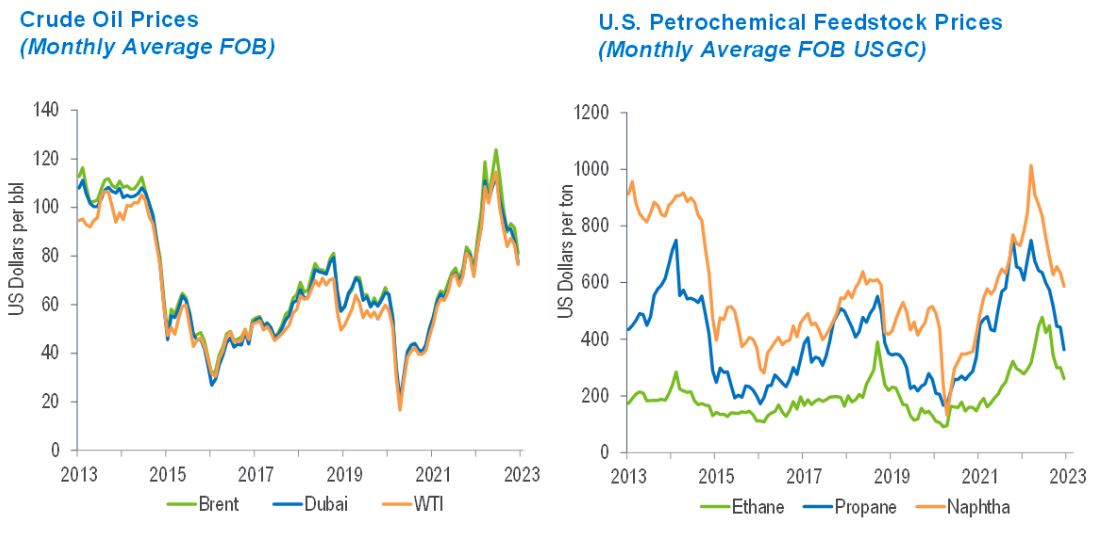Crude oil and refining: Quarter four performance

Energy cost burden narrows as slow demand clears supply side risk premium from prices towards year end
World oil markets weakened in the closing months of 2022 as demand side pressures due to the hastening downturn in global economic activity displaced supply side pressures of extensive cuts to OPEC+ production quotas. Crude oil prices cleared the risk premium built alongside the emerging conflict in Ukraine, dropping more than 30 percent through the second half of the year. Brent crude oil prices were capped below $85 per barrel through December, settling close to where they opened the year. Firm fuel values defined a floor to petrochemical feedstock costs. Naphtha prices stagnated at a 16-month low as global consumption into petrochemical derivatives deteriorated. Profitability remained focused in the refinery as middle distillate crack spreads remained elevated.
Crude oil prices NexantECA
Intense cost pressure stalled demand growth on reverting to pre-pandemic volumes
Growth in world oil demand slowed considerably through the second half of 2022, with normalisation from the COVID-19 pandemic largely completed in markets outside of China. World oil demand was estimated above 101 million barrels per day (mmbpd) for the first time since the second half of 2019. A deteriorating global economic climate headed by steepening inflation rates slowed annual demand growth towards 1.5 percent. A cautious zero COVID-19 policy in China depressed annual demand more than two percent on the year in the last three quarters. Kerosene demand slumped 50 percent and gasoline demand stalled 12 percent on the year in October as personal mobility faced persistent restrictions. Supply disruption and firm cost pressures have stalled European demand since the conflict in Ukraine deepened in quarter two. A five percent contraction in diesel demand offset 30 percent growth in kerosine demand on revival of aviation business. Tight global gas markets and elevated prices promoted substitution, enhancing growth in demand for fuel oil and LPG in Western markets.
Elevated prices lengthened supply against subdued demand alleviating lost favour of Russian crude
Global oil markets weakened through the second half of 2022 as supply lengthened ahead of slowing demand. The elevated price point for crude oil created inertia in supply which increased towards pre-pandemic volumes by the end of the year. Estimated global oil production of 101.5 mmbpd in November increased 3.3 percent on the year. The United States led the upturn in world supply offering most of the 2.1 mmbpd increase in non-OPEC Supply. Production in Russia stabilised closed to 2021 volumes, recovering losses in quarter two following the conflict in Ukraine. Slowing global demand and the steady drop in crude oil prices prompted OPEC+ to cut 2mmbpd from production quotas in November. OPEC share of world supply narrowed 0.2 percent to approach 28 percent as global production retained momentum.
OPEC+ production cuts slowed oil price decline but risk premium built in H1 cleared by year end
Agreement of heavy cuts to OPEC+ production quotas briefly prompted crude oil prices to rebound into October on fears of tightening markets against seasonal fuel demand. Brent crude oil prices recovered losses surrendered to weakening markets through September and gained four percent to average US$93 per barrel through October. The hastening downturn in the global economic climate coupled with further weakening of the dollar and renewed COVID-19 restrictions in China swiftly reversed gains through November. Deteriorating market sentiment depressed crude oil prices towards where they opened the year, with Brent crude oil prices retreating to settle below $85 per barrel through December.
Resilient demand for fuels lent inertia to petrochemical feedstock costs as oil prices moderated
Firm fuel values shielded petrochemical feedstock costs from moderating crude oil prices. The immense premium implied on gasoline blending led naphtha prices to stagnate after frail petrochemical demand plunged naphtha prices to a 16-month low in August ahead of latest downturn in crude oil prices. Tight global gas markets continued to constrain competitiveness of lighter feedstocks as global gas prices retained a premium over the price point in January. Ethane prices in the United States retreated below $300 per ton but remain at the upper end of the range explored over the last decade. Crack spreads on middle distillate fuels have eased from their mid-year peak but remain elevated, offering lucrative refinery margins.
Find out more...
Quarterly Business Analysis: Global - Petrochemicals, Polymers and C1 Chemicals - Q4 2022
Quarterly Business Analysis: Middle East - Q4
The Quarterly Business Analysis provides key insight into production economics for a broad range of commodity petrochemicals, polymers and C1 chemicals. The analysis presents a review of costs, prices and margins for typical production assets, providing a valuable view of regional and value chain competitiveness and is is available for each key price setting region - Asia Pacific, Middle East, Western Europe and the United States. A quarterly report provides insightful commentary to illustrate current trends, related to recent market developments. The accompanying database is updated monthly.
